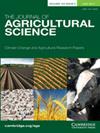玉米植株密度对麦草畏籽粒产量和苋菜响应的影响
IF 1.7
4区 农林科学
Q2 AGRICULTURE, MULTIDISCIPLINARY
引用次数: 0
摘要
苋菜(Amaranthus palmeri S. Wats.)主要生长在堪萨斯州(KS)的休耕和耕地中。在小麦-玉米-休耕轮作(WCF)的玉米年,我们研究了玉米(Zea mays L.)株密度对籽粒产量的影响以及KSP对麦草畏的响应。试验采用随机完全区组设计,4个重复,处理采用分块处理。主要地块以5种密度种植玉米(49,400;61700;74100;86,400株和98,800株(hm -1)和子样地由6个剂量的麦草畏[(70,140,210,280,420和560 g hm -1)在V6附近施用]、杂草检查和无杂草检查组成。一般来说,只有当玉米种植密度≥74,100株/ hm -1时,麦草枯剂量< 560 g / hm -1才能达到可接受的粮食产量和KSP控制。根据ED50的估计,当玉米植株密度从49,400株/公顷增加到98,800株/公顷时,KSP需要减少4.4% -8.2%的麦草畏来降低高度和生物量。相反,当玉米株密度从49,400株ha-1增加到98,800株ha-1时,将KSP密度降低50%所需的麦草畏用量分别从144.4 g ae -1增加到209.6 g ae -1,增加了45.1%。综上所述,本研究表明玉米高密度种植与麦草畏的结合是一种经济有效的控制棕榈蚜的方法。然而,如果没有其他更多样化和更强大的策略,包括使用苗期前和苗期后除草剂计划,这些计划与文化、生物和机械杂草控制策略重叠,就无法实现抗性缓解和对该物种的长期控制。本文章由计算机程序翻译,如有差异,请以英文原文为准。
Corn Plant Density Effects on Grain Yield and Palmer Amaranth Response to Dicamba
Palmer amaranth (Amaranthus palmeri S. Wats.) is primarily found in fallow and cultivated fields throughout Kansas (KS). Previously, we reported that the effective dose of dicamba for 50% control (ED50) of a 10-30 cm tall A. palmeri accession from KS (KSP) during the fallow-year of a wheat-corn-fallow rotation (WCF) ranged between 40.4 to 283.5 g ae ha-1 Here, we investigated corn (Zea mays L.) plant density effects on grain yield and the KSP response to dicamba in the corn-year of the WCF rotation. The experiments used a randomized complete block design with four replicates and a split-plot arrangement of treatments. Main plots consisted of corn planted at five densities (49,400; 61,700; 74,100; 86,400 and 98,800 plants ha-1) and sub-plots consisted of six doses of dicamba [(70, 140, 210, 280, 420, and 560 g ae ha-1) applied near V6], a weedy-check, and a weed-free check. In general, acceptable grain yield and KSP control with dicamba doses < 560 g ae ha-1 were only achieved when corn was planted at a density ≥ 74,100 plants ha-1. Based on the ED50 estimates, the KSP required 4.4-8.2% less dicamba for height and biomass reduction as corn plant density increased from 49,400 to 98,800 plants ha-1. Conversely, the amount of dicamba required for 50% reduction of KSP density increased 45.1% from 144.4 to 209.6 g ae ha-1 as corn plant density increased from 49,400 to 98,800 plants ha-1, respectively. Taken together, this study shows that integration of high-density corn planting with dicamba is a cost-effective tool for controlling A. palmeri. However, resistance mitigation and a season-long control of this species cannot be achieved without the integration of other more diversified and robust strategies that include the use of preemergence fb postemergence herbicide programs that overlap residuals with cultural, biological, and mechanical weed control tactics.
求助全文
通过发布文献求助,成功后即可免费获取论文全文。
去求助
来源期刊

Journal of Agricultural Science
农林科学-农业综合
CiteScore
2.80
自引率
5.00%
发文量
68
审稿时长
1.4 months
期刊介绍:
The Journal of Agricultural Science publishes papers concerned with the advance of agriculture and the use of land resources throughout the world. It publishes original scientific work related to strategic and applied studies in all aspects of agricultural science and exploited species, as well as reviews of scientific topics of current agricultural relevance. Specific topics of interest include (but are not confined to): all aspects of crop and animal physiology, modelling of crop and animal systems, the scientific underpinning of agronomy and husbandry, animal welfare and behaviour, soil science, plant and animal product quality, plant and animal nutrition, engineering solutions, decision support systems, land use, environmental impacts of agriculture and forestry, impacts of climate change, rural biodiversity, experimental design and statistical analysis, and the application of new analytical and study methods (including genetic diversity and molecular biology approaches). The journal also publishes book reviews and letters. Occasional themed issues are published which have recently included centenary reviews, wheat papers and modelling animal systems.
 求助内容:
求助内容: 应助结果提醒方式:
应助结果提醒方式:


